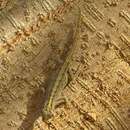en
names in breadcrumbs


An arboreal diurnal species. Animals communicate by tail signals, where tails are waved horizontally and vertically and curled above the back. The body and head are also bobbed up and down in push-up-like motions. Animals are territorial and defend their particular branches or trees sometimes quite vigorously. The female has a clutch of a single almost spherical egg, which she lays in a shallow depression she digs with her hind legs under an object. Several clutches are laid per season.
A small gecko with maximum recorded SVL 38 mm. Head and body not depressed. Tail relatively long (average tail/SVL ratio = 1.5), slender, and laterally compressed (particularly in males); with a mid-dorsal line of enlarged scales. In males these scales are notably elongate and form an obvious crest that extends anteriorly onto the sacrum. A weak subcaudal fringe might be present in some males as well. Dorsals homogenous, small and granular; ventrals slightly larger and subimbricate. Mid-dorsals might be slightly enlarged, forming a weak fringe that extends from the tail to the neck in some males. No post-mental shields. Subdigital scales smooth, some with callous like growth. Basic dorsal coloration grayish, with a series of about 8 chevron-like dark marks on mid-dorsum, which extend onto the tail. Flanks with small maroon specks and streaks. A dark line extends from rostral through eyes to above the ears. Venter gray-white, but throat, neck, and sides of abdomen usually with dark streaks and spots. Iris golden brown. Regenerated tail with an ill-developed crest in males. Sexual dimorphism is considerable. Males are more lateally compressed; have a well-developed crest on the dorsal side of the tail; coloration is more uniform gray with more obvious maroon spotting on the flanks. Females, on the other hand, have a more cylindrical body, little evidence of a tail crest, and usually a pale yellowish mid-dorsal strip that extends from the occiput onto the tail. Juveniles and hatchlings are similar to the females in having a very pronounced mid-dorsal stripe.
Southeast Egypt, from the Egyptian-Sudanese borders to at least 25°13'N along the Red Sea coast. Recorded initially from the environs of Gebel Elba, but now known to have a much wider distribution in Egypt. Recently recorded from Shalatein, Wadi Lahmi, Wadi El Gemal, Gebel Hamata, and north of Marsa Alam. The most-inland record is from the Bir Abraq area.
Egypt south through eastern Sudan, Eritrea to Somalia; east to southwestern Saudi Arabia, and Yemen. In Sudan the species penetrates quite far inland in the Nile Valley from Sennar, Singa, and Kirbekan (aprox. 18°50'N 32°20'E).
In Egypt it is found on a variety of vegetation, where sufficient complexity is available to provide refuge. It has mainly been recorded from Acacia sp. and Balanites aegyptiaca trees, and Lycium sp., Tamarix aphylla and T. nilotica thickets. Saleh's (1997) statement that the species inhabits "Rocky areas, where it can be seen jumping on rocks" is inexplicable. It is largely restricted to regions where the distribution and density of vegetation allows for contact among populations of the species. It is distributed inland along wadi systems where vegetation grows more or less in a linear fashion, and extends northward along the Red Sea coast utilizing the narrow band of salt marsh vegetation which exists along that coast. Despite the general extreme scarcity of vegetation in habitats occupied by this species in Egypt, animals have been encountered in very isolated trees, where high densities are often found. Long movements between clusters of vegetation are likely to take place at night, as was noted for P. minimus in Abu Dhabi. Only a single animal was found 'active' at night, standing on a stump of a Tamarix tree near the ground in Wadi El Gemal.
Uncommon and highly localized. Populations are highly susceptible to vegetation degradation and destruction.
Pristurus flavipunctatus, also known as Rüppell's semaphore gecko or Middle Eastern rock gecko , is a species of lizard in the Sphaerodactylidae family found in Ethiopia, Saudi Arabia, Egypt, Djibouti, Somalia, Sudan, Eritrea, and Jordan.[1]
Pristurus flavipunctatus, also known as Rüppell's semaphore gecko or Middle Eastern rock gecko , is a species of lizard in the Sphaerodactylidae family found in Ethiopia, Saudi Arabia, Egypt, Djibouti, Somalia, Sudan, Eritrea, and Jordan.